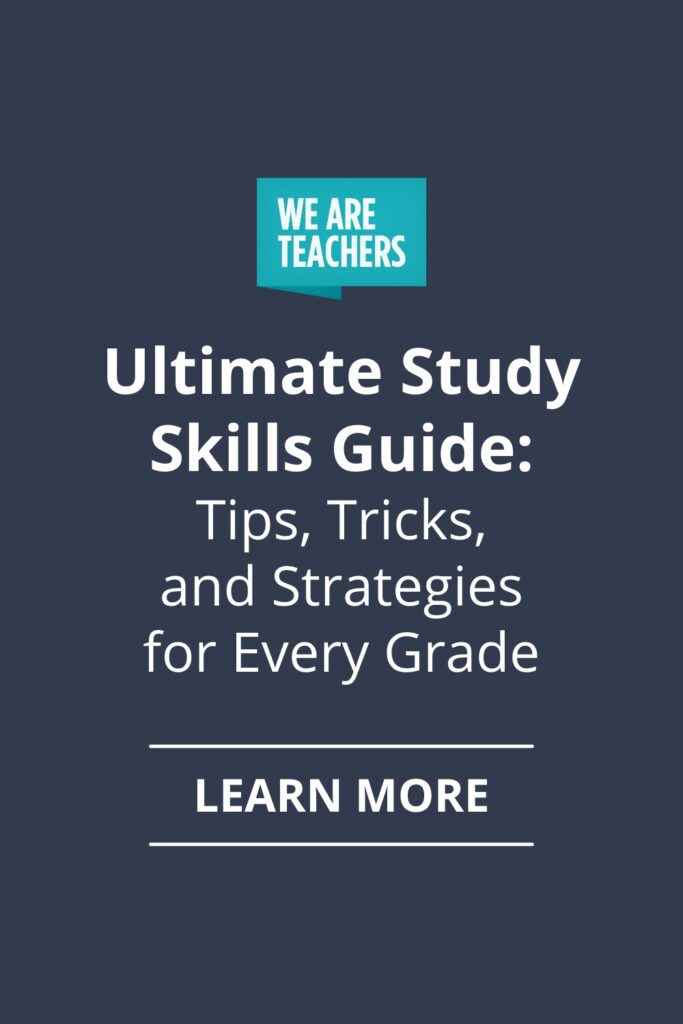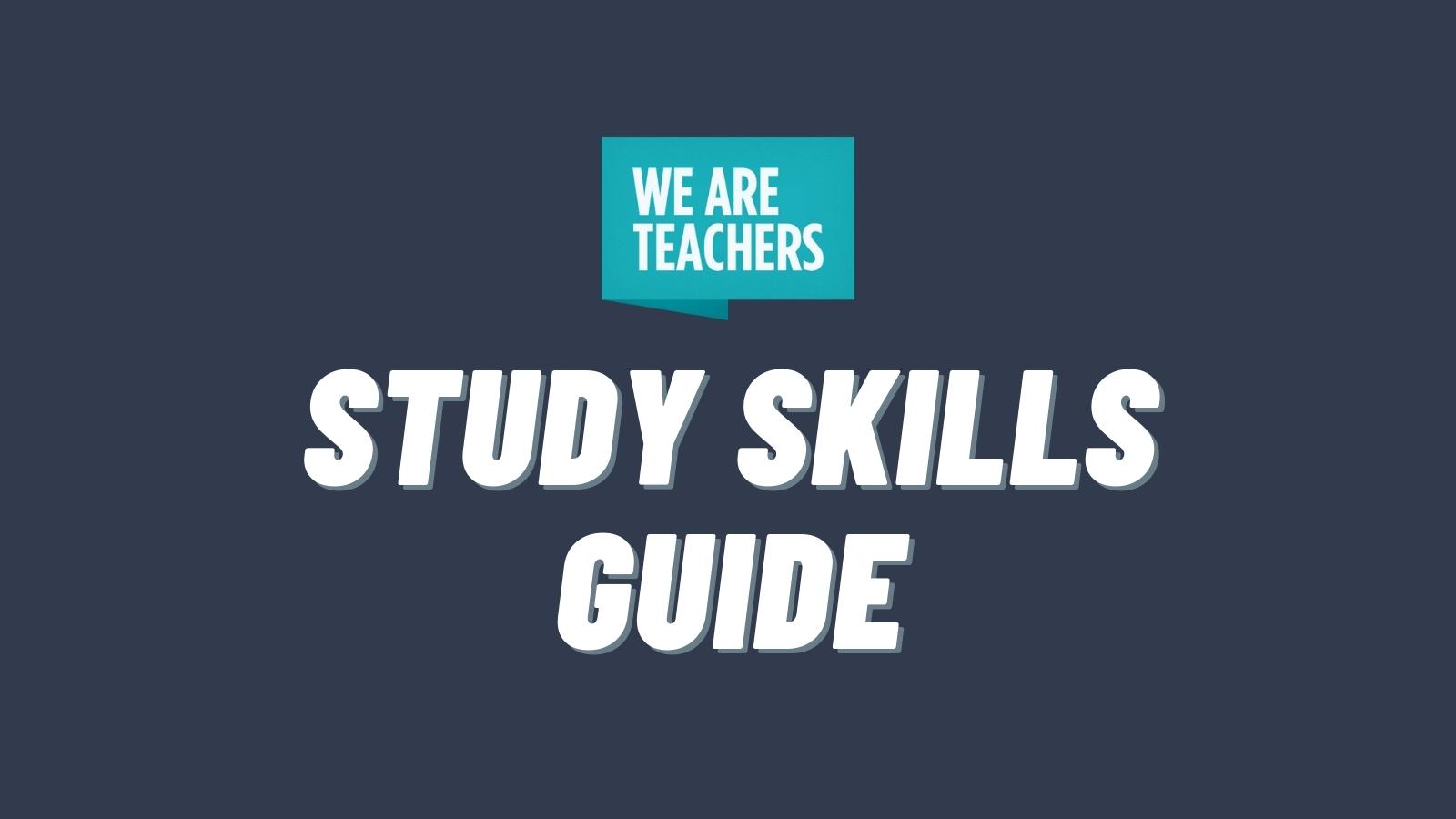It’s not an exaggeration to say that study skills are life skills. Taking good notes, creating a focused workspace, managing distractions, making plans—any and all of these are skills people of all ages use every single day. Taking time to teach good study skills up front can equip students to succeed in school and beyond.
We’ve broken down many of the top study skills students need, including examples by grade level. Remember that there are a lot of different ways to study successfully. Offer students options and help them find the strategies that work best for them.
Jump to:
- Study Spaces
- Organization and Time Management Study Skills
- Learning Styles
- Taking and Using Notes
- Effective Reading Study Skills
- Completing Assignments
- Test Taking
- Finding Help
Study Spaces

Choosing the right place to study is the first step to good study skills. Teach students to consider these elements.
Choose Your Space
For some students, this means a dedicated study space like a desk in their room. Others may prefer to curl up in a chair with a lap desk or work at a table in a common space. Whichever they choose, it should be an area that’s dedicated to study while they’re using it.
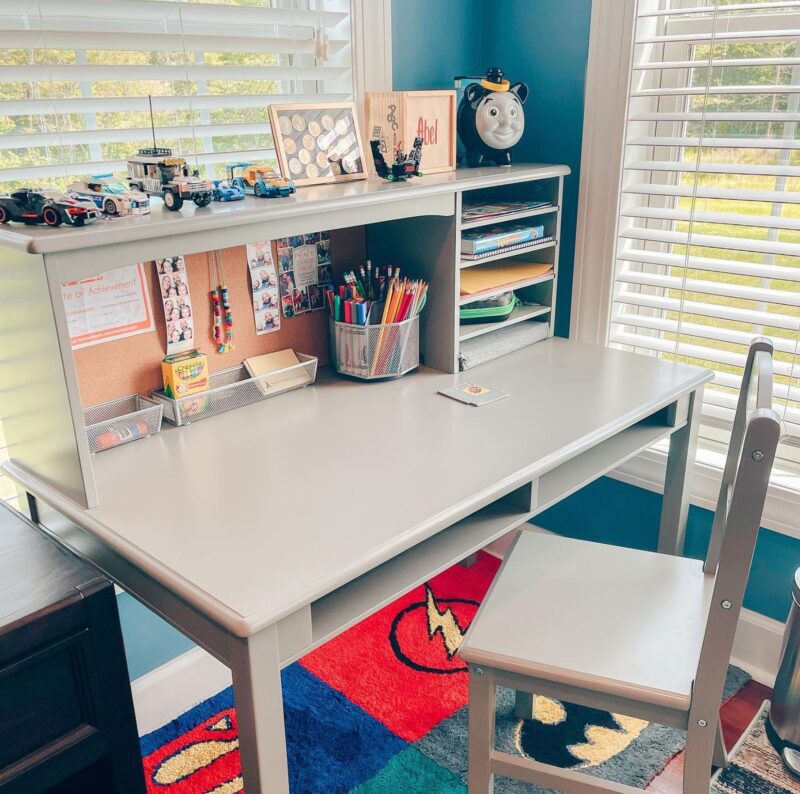
Source: organizeandarrangeit/Instagram
- Elementary School: Many students begin doing homework on the dining room or kitchen table, where parents can supervise. As students get older, encourage them to explore other spaces too, especially those where they can work independently.
- Middle School: By this age, kids will probably need a dedicated study space of their own, where they can keep supplies and works-in-progress. If that’s not possible, create a bin or box where they can store stuff while they’re not using it, then pull it out when it’s time to study.
- High School: Older students should be able to carve out a study space pretty much anywhere, since that’s something they’ll need to be able to do in the working world too. As long as they’re able to concentrate and get their work done, don’t be too picky about where they choose to do it.
Make Yourself Comfortable
“Comfortable” looks different for every person, so don’t assume all kids need to be sitting at a desk to work well. At the same time, they shouldn’t be so comfortable that they’ll fall asleep!
- Elementary School: When kids are doing independent reading, let them choose any spot they like. For other work, make sure they have a sturdy writing surface, like a table or lap desk. Ensure they have enough light to see what they’re doing, and teach them good posture if they’re sitting in a chair so they don’t develop stiff muscles.
- Middle and High School: Show them how to adjust the font size on screens so they’re not squinting to read. Encourage them to use blue light filters if they’re spending a lot of time on computers.
Manage Distractions
Learning to concentrate while ignoring distractions is a key life skill, and one that we all need to develop. Some students will have no trouble tuning things out, while others are going to need a lot of help with this one.
- Elementary School: Kids at this age are very easily distracted, so their study space should be as calm as possible. If a quiet room isn’t available, they might need noise-canceling headphones or even a white-noise machine to help them concentrate. Muting the TV isn’t enough—be sure it’s off completely. Remind friends and siblings to leave kids alone while they’re working.
- Middle School: These kids are old enough to recognize distractions but might still have trouble handling them. Encourage them to turn off phones and electronics (although some students are fine listening to music while they work). Students at this age are old enough to politely ask friends or family not to interrupt them while they work.
- High School: By this time, students know that the world is full of distractions and you can’t quiet them all. But you can teach them to mute their phone and messaging notifications, close all unnecessary windows on their laptops, and be firm about letting others know they need to be left alone to study.
Gather Your Supplies
One way to eliminate distractions is to ensure you have everything you need in place before you start. This includes books, notes, office supplies, and more. All kids should have water and some healthy snacks on hand too.
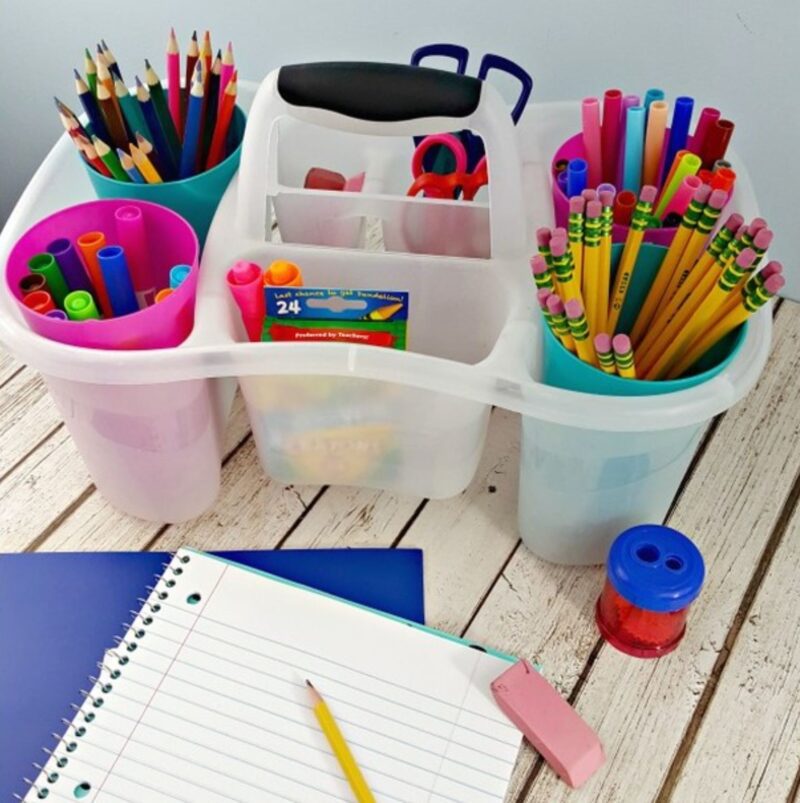
Source: jugglingactmama/Instagram
- Elementary School: Having a dedicated, well-stocked study space makes it much easier for kids to settle down to their work. Keep a supply of sharpened pencils, glue sticks, scissors, markers, and other items in a nearby drawer or a bin they can grab when they’re ready to get started.
- Middle School: Students this age likely keep just about everything they need in their backpacks, so they’ll want it nearby when they study. Remind them to restock their supplies once a week (including sharpening pencils in advance).
- High School: Depending on the assignment, these students may not need a lot of physical supplies, but they should still gather any books, notes, laptops, pens and highlighters, etc., they need before they settle in for a study session.
Organization and Time Management Study Skills

These two study skills are also vital life skills, so the sooner kids learn them, the better. They’ll be grateful later in life!
Use a Homework Planner
As soon as kids starting having any kind of homework, they need a planner. For younger students, this could be a daily take-home folder, while older kids will need a more sophisticated system. Either way, use it consistently so it becomes a habit.
- Elementary School: Take-home folders are perfect for organizing worksheets and other assignments. Put unfinished work on the left and finished work on the right. Use sticky notes on the worksheets or the front of the folder to write reminders about what needs to be done, including any due dates. Parents of younger students can review these folders each day, while upper elementary kids should mostly be able to keep track of things on their own.

Source: Busy Classroom
- Middle School: Use a planner notebook that includes calendars to help keep track of long-term assignments, with pages for daily notes and to-do lists. Teach students to make notes in them during class or immediately after, and start every study session by reviewing any current assignments and their due dates.
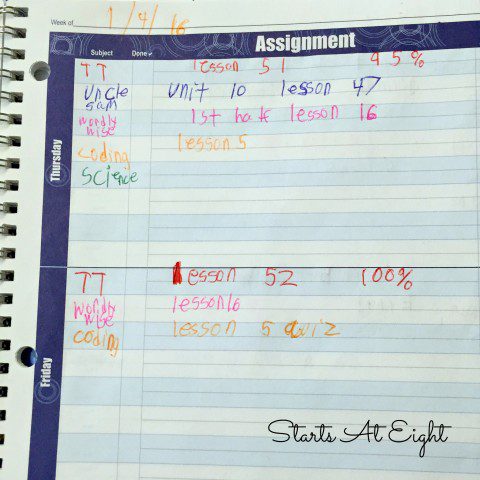
Source: Starts at Eight
- High School: Kids can continue using paper planners, or transition to online calendars or apps. Show them how to set useful reminders online, so things don’t slip through the cracks.
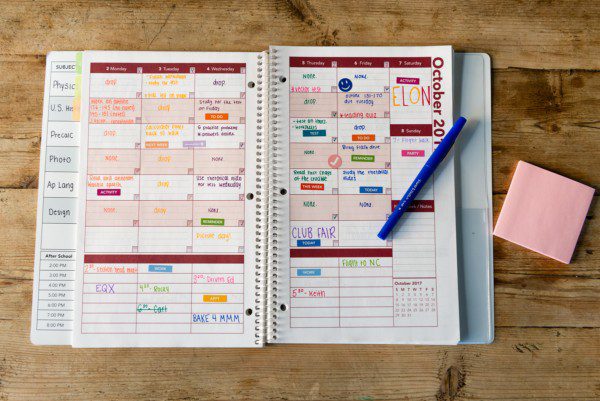
Source: LP Tutoring
Create a Daily Study Plan
When kids sit down to tackle the day’s work, encourage them to begin by making a plan. Assess what needs to be done, estimate the amount of time it will take, and decide what to do first.

Source: Beyond Booksmart
- Elementary School: Parents and young kids should sit down together to look over the day’s assignments and talk about what to work on first. Some students might like to get easy tasks out of the way before settling in to harder ones, while others prefer to handle more difficult things first. Help them find the method that works best for them.
- Middle School and High School: This age brings a higher amount of homework, so students should always start by determining how much time they’ll need to complete it. Let them experiment a bit—do they work best by completely finishing one assignment before moving on to the next, or do they like to do a little bit of each and take some breaks in between? Over time, they’ll find the methods they like best.
Chose the Best Study Time
Kids’ days are often jam-packed with activities, leaving homework and studying to get squeezed in whenever it fits. Take time to find out what time of day kids are at their best, and prioritize that time for study. For instance, if a student seems to learn better if they do their homework right after school, try to choose extracurriculars that meet in the evenings or weekends instead. Some students might even prefer to get up early in the morning and work, and that’s OK too as long as they’re getting enough sleep.
- Elementary School: Let kids try doing their homework at different times throughout the day, and see if there are times when they’re better at concentrating. If so, teach them to schedule their schoolwork during those times, and make extracurricular choices for them accordingly.
- Middle and High School: Students probably know by now when they work best, but busy schedules can make that more difficult to accommodate. Remind them to try to make smart choices and to tackle schoolwork when they’re feeling as fresh and alert as possible.
Keep Materials Neat and Organized
Some adults thrive in messy work spaces, and that’s OK. But kids should make an effort to keep their spaces and materials organized so they have fewer excuses for not getting things done.
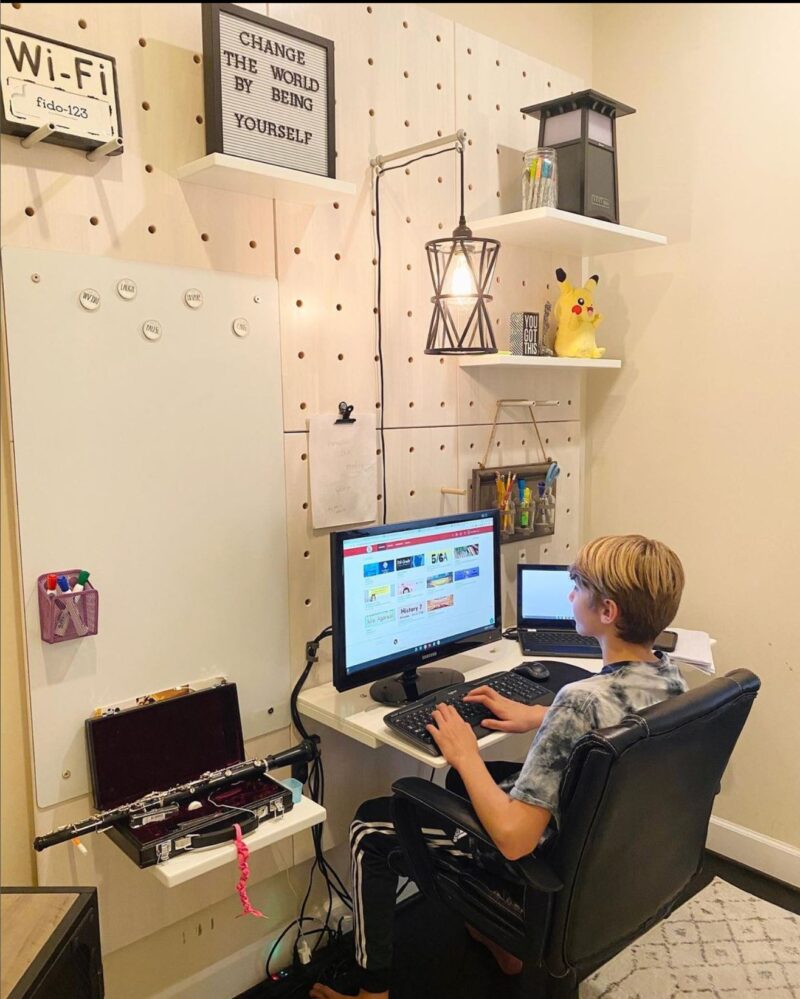
Source: mywallpro/Instagram
- Elementary School: In early grades, parents should help kids go through their backpack each night, cleaning out trash and restocking supplies. Help them set up an organization system using the different pockets. Show them how to use different-color folders and notebooks for each subject, and clean out every folder regularly. Set the backpack by the front door each night so it’s ready to go in the morning. Upper grade students should gradually do some or all of these things on their own.
- Middle School: Transition to entirely managing backpacks and study spaces on their own. Parents might check in once a week or at the beginning of a school quarter to see if students need some assistance getting organized.
- High School: In addition to managing their physical study materials, ensure kids at this age know how to keep things organized online. Show them how to use files and folders, where to back things up, and how to manage their email and message inboxes. Encourage them to set aside a regular time to make sure everything is in order, and make improvements as needed.
Take Breaks
Students need both physical and mental brain breaks while they study! Remind kids to get up and move around regularly, rest their eyes, and give their brain a break for a few minutes every so often.
- Elementary School: Younger students should be able to work for about 15-20 minutes before taking a break, with upper grades going as long as 30 minutes. They usually won’t need reminders to take breaks, but they might need some help keeping those breaks to no more than 10 minutes or so.
- Middle School: These kids can work 30-45 minutes at a time and should learn to recognize the signs of needing a break on their own. When they start to get very fidgety, feel a headache coming on, squint while they’re reading, or feel hungry or thirsty, it’s time for a short break. Teach them to set a timer to know when the break is over and they need to get back to work.
- High School: By now, students can work an hour at a time but should be encouraged to take regular breaks all the same. In fact, just like adults, they should aim to get up and move for at least 5 minutes every hour. Physical activity like stretching, yoga, or even dancing to music will help refresh them so they can get back down to it. If they have trouble remembering to take breaks, have them set a timer to remind them.
Learning Styles

All students use different learning methods to retain and understand the same information. Some like written words, some prefer to hear it and talk about it. Others need to do something with their hands or see images and diagrams. These are known as learning styles. While it’s important not to pigeonhole students into any one style, kids should be aware of any strengths they have and use them to create strong study skills.
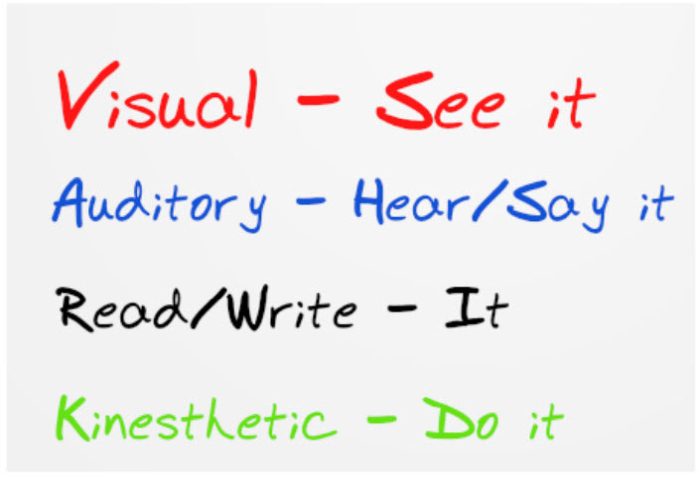
Source: Nnenna Walters
Know Your Style
There are four generally accepted styles: visual, auditory, read/write, and kinesthetic (movement). You can learn more about them here. It’s worth taking time to understand which (if any) style appeals to a student more.
- Elementary School: Most kids are exposed to a wide array of learning activities, strategies, and methods here and will slowly form preferences. If parents or teachers notice that kids aren’t learning well using one method (e.g., flash cards to learn math facts), have students try activities from different styles instead (like videos or songs).
- Middle School: At this age, students should have some idea of which study methods fit their learning styles. They should continue to experiment, especially in subjects where they struggle to master the material.
- High School: Kids in these grades who still don’t understand how they learn best may benefit from taking the VARK questionnaire. It will point them in the right direction and help them find the best study methods.
Choose Appropriate Study Materials
Here are some examples of study materials and activities that appeal to different learning styles, no matter the age or grade level.
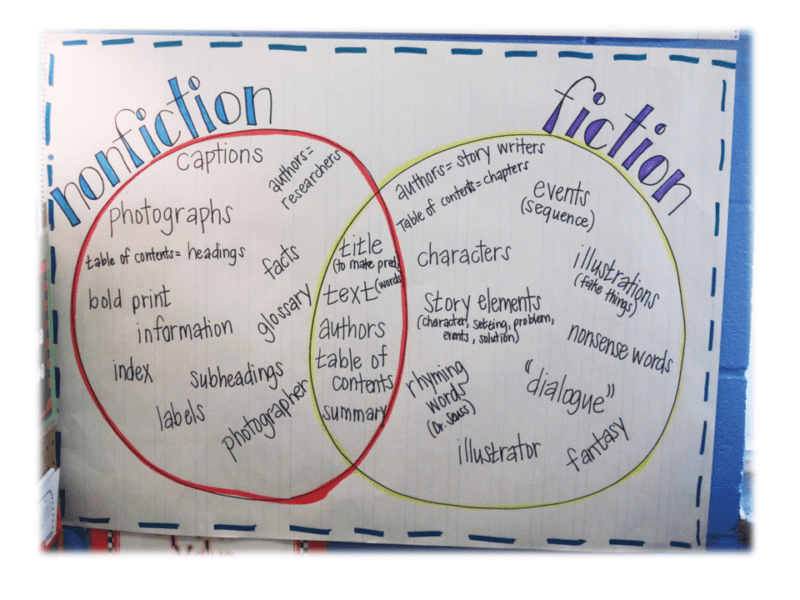
Source: Elementary Shenanigans
- Visual: Diagrams; charts; graphs; maps; videos with or without sound; photos and other images; graphic organizers and sketchnotes
- Auditory: Lectures; audiobooks; videos with sound; music and songs; text-to-speech translation; discussion and debate; teaching others
- Read/Write: Reading textbooks, articles, and handouts; watching video with subtitles turned on; using speech-to-text translation and transcripts; making lists; writing answers to questions
- Kinesthetic: Hands-on practice; educational craft projects; experiments and demonstrations; trial and error; moving and playing games while learning
Taking and Using Notes

Study after study have shown the importance of actively taking notes rather than passively reading a handout later on. The act of writing engages different parts of the brain, forging new pathways that help students retain information in long-term memory. Taking good notes and using them properly are study skills every student needs to master.
Learn Different Note-Taking Strategies
There are a variety of good strategies, like outlines, the Cornell Method, sketchnotes, and more. There’s no one best method; it often depends on the material and the learner.
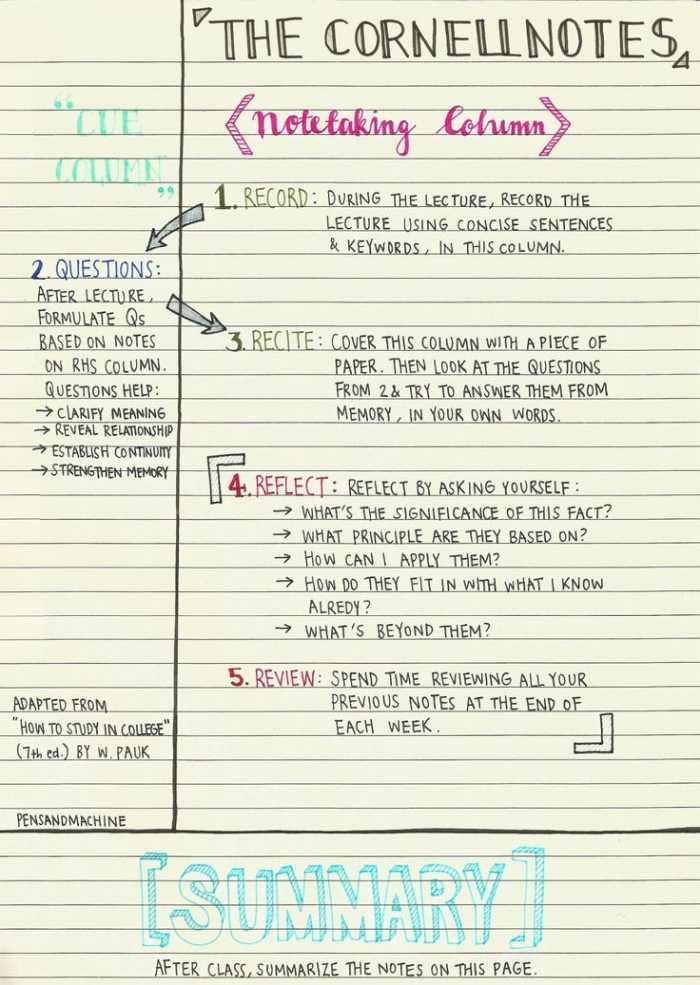
Source: Think Insights
- Elementary School: Actively teach kids how to take notes in a variety of styles. Learn about seven top note-taking strategies here, and share them with your students. Teachers can start with handouts and graphic organizers but should slowly transition to more independent methods.
- Middle School: Students should be mastering the skill of taking their own notes, choosing a style that works best for them. They may need reminders of key points to capture but should now be able to isolate the important info.
- High School: Note-taking should be automatic by now, and many students will have developed preferred styles. Teachers should not insist on a specific note-taking strategy, but should ensure kids are capturing the information they need.
Organize and Review
Taking notes is just one part of the process. Students with good study skills also know how to use them effectively.

Source: The Mad Scientist
- Elementary School: Help students keep all notes from one subject or project in one notebook or folder. Show them how to place them in an order that makes sense, and use tabs, tables of contents, or other organizational methods. Encourage them to review each day’s notes when they go home at night, to reinforce the learning.
- Middle School: Students in these grades might want to reorganize their notes on their own when they get home, re-copying them or even typing them into a computer. They should be able to use effective organization strategies, to find the notes they need later on during a study session.
- High School: Students should plan to spend time after every class going over that day’s notes, reviewing and reinforcing what they learned. They should be able to rely heavily on their own notes when reviewing for a test or completing a project.
Effective Reading Study Skills

“Read chapter three for homework tonight.” Sounds simple enough, right? But there’s a big difference between skimming the material and actually learning from it. Here are the study skills students need to learn while they read.
Highlighting
Everybody loves a handful of colorful highlighters, but using them effectively is a study skill all on its own. Kids can highlight both texts and their own notes.
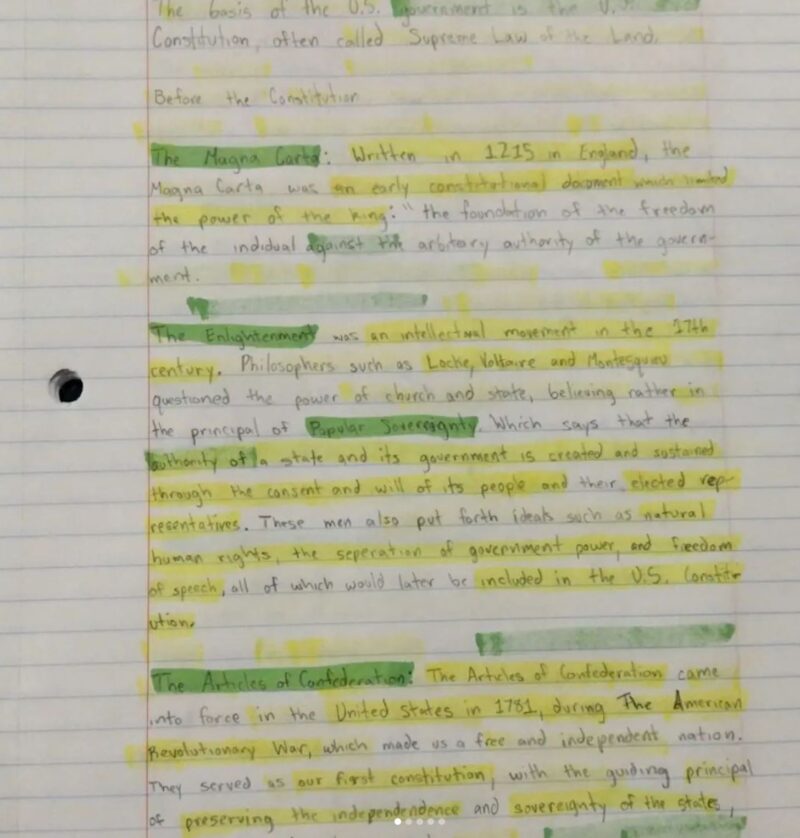
Source: cozmic_mae/Instagram
- Elementary School: Read material with students, showing them how to highlight key words and phrases instead of whole blocks of text. Show them color-coding strategies for organizing the information. Give them practice passages specifically for learning these skills.
- Middle School: Introduce students to online highlighting tools, since many of the texts they’ll be reading are digital. If necessary, they can print out reading material to highlight physically instead.
- High School: Kids should be pretty expert at highlighting by now, but watch for students who are still highlighting whole blocks without really knowing why, and show them the fundamentals.
Rereading and Taking Notes
In a lot of cases, reading something once simply isn’t enough. All students should learn to reread materials, using that time to highlight and take notes.

Source: SERC
- Elementary School: Reread passages together, pointing out key words, phrases, and ideas. Make notes while reading, both in the text and on separate paper. Try to complete review questions without referring to the text.
- Middle School: Students will know they’ve read thoroughly when they can complete review questions without looking back. Show students how to write their own review questions as they study (the Cornell Method of Note-Taking is perfect for this) so they’ll know they truly understand the material.
- High School: Continue to reinforce good reading study skills by giving students review questions to complete or asking them to make an outline or sketchnotes to sum up what they’ve learned.
Completing Assignments
Kids need to learn how to thoroughly complete an assignment, whether it’s a worksheet, an essay, or a term-long research project. These are the study skills they should know.
Understand the Assignment
Having a clear understanding of what’s being asked is so important. Otherwise, kids might wind up doing the wrong work, then having to tackle it all over again.
- Elementary School: Show kids how to carefully read directions at the beginning. Have them repeat back what they’re expected to do, and make notes if they need reminders. Teachers should provide instructions in writing whenever possible and make them clear and simple.
- Middle School: Encourage students to ask questions about assignments up front, or throughout if necessary. Continue to ensure they fully understand the directions before they start, especially when there are multiple steps.
- High School: By now, students should be able to make their own notes about expectations and can handle a series of more complicated steps. They should make a habit of reviewing all that information before they begin work.
Make a Plan
Once they know the expectations, students should plan how they’ll do the work.
- Elementary School: Help students evaluate the assignment and decide which parts they’ll do first. This is also a good time to estimate how long the work will take.
- Middle School: Encourage kids to think about how they like to approach assignments. Do they like doing easy problems first, then circling back around to harder stuff? Do they sometimes get stuck and frustrated? If so, how can they get “unstuck” and continue to make progress?
- High School: Many high school assignments are more complex, and students will need to lay out the steps to take. For instance, a research project might require choosing a topic, getting approval, starting research, planning a presentation, and giving the presentation, with multiple sub-steps in each. This all feels more manageable when you have a plan in place first.
Save Your Work
Such a basic study skill, and so extremely important!
- Elementary School: Help students ensure all assignments go back into the appropriate folders and all folders make it into their backpack when they’re done. Don’t leave things lying around where they can get lost.
- Middle and High School: In addition to keeping physical papers in order, be sure kids know how to save files online, including backing up their work. Many programs save automatically, but that’s not always the case. Show them how to keep backed-up files on an external drive or in the cloud, in case their hardware fails.
Review and Revise
Finishing the last problem on the page or typing the final word on a paper doesn’t mean you’re done. Good study skills means going back to review your work and make revisions.
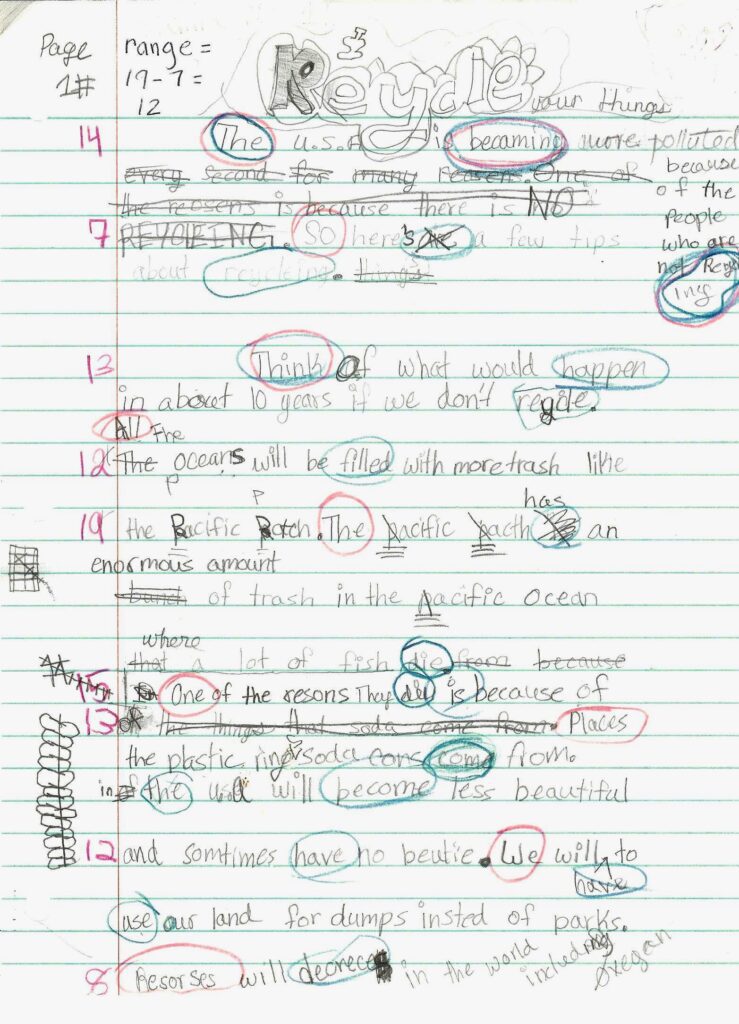
Source: EnglishWritingTeacher.com
- Elementary School: Parents and younger kids should go back over completed homework together to make sure it’s complete and correct. Perform math problems “backwards” to see if the answers make sense. As kids get older, parents should remind them to review and check their answers on their own.
- Middle School: Students should regularly remember to check their answers before turning in an assignment. Advise them to make sure they’ve done everything they’ve been asked to, to the best of their ability.
- High School: Reviewing and revising should be automatic now. Writing assignments should include plans for multiple revisions. Teach students to use spell-check and grammar-check programs as needed, and encourage them to read their writing out loud to hear how it sounds.
Test Taking

Some kids naturally do well on tests, but others freeze up and forget everything they’ve learned. Fortunately, test-taking study skills are something kids can learn over time.

Source: Tammy DeShaw/The Owl Teacher
Review the Material
Kids should develop a variety of strategies for reviewing for a test, including review questions, flash cards, discussions, looking over notes, and more. It’s also important to follow a regular study schedule on any subject, instead of leaving all the review to the last minute.
- Elementary School: Whenever possible, adults should work with kids to help them study. Make flash cards, talk over the material together, sing spelling word songs—model good study skills for them to help them learn.
- Middle School: Help students continue to use a variety of review strategies. Teachers can provide review questions, set up study groups, and create online materials for them to use, just to name a few.
- High School: Kids should be coordinating their own review by now, whether independently or in groups. Make sure they know how to contact you if they have questions while they’re studying.
Get Rest and Eat Well
At any age, feeling your best is key to acing a test. Discourage students from staying up late to cram, and see that they have healthy meals and snacks on the day of the test. If they’re allowed, be sure they have bottled water on hand to stay hydrated before and during the test itself.
Tackle Easy Questions First
This one is especially important for students who have difficulty managing their time, or those who get incredibly nervous about tests. Focus on showing what you know, and build confidence as you go along.
- Elementary School: Teach kids to look over the entire test first so they can see what they’ll be expected to do. Tell them to ask questions right away if they have any. On the second run-through, they should answer any questions or problems they’re certain about. Finally, they can go back and handle more challenging questions, one at a time. In younger grades, practice this skill by using guided test-taking sessions.
- Middle School: Before a test, remind students of the process. Have them look the whole thing over first, and ask if anyone has any general questions before they begin. Monitor kids as they complete the test, and nudge along any who seem stuck on one particular question or section.
- High School: By now, kids should have the process down pat, but teachers should be aware of nervous test-takers and quietly remind them to focus on what they know.
Watch the Time
It’s a simple skill but a valuable one. Get kids used to glancing at the clock, but not obsessing over how much time is left.
- Elementary School: Tell kids how much time they have up front. Offer reminders several times, especially toward the end, but don’t do it in a way that amps up anxiety.
- Middle School: Make time expectations clear up front, and remind students once or twice of the remaining time as they work. Students should be glancing at the clock occasionally as they work; at the end of every page or section is a good rule of thumb. If they feel like they’re running out of time, remind them to use the “easy questions first” strategy.
- High School: Older students should be able to look over a test and compare it to the amount of time they have, so they know they’re working at the right pace. Teachers can offer a reminder halfway through and five minutes before the end.
Review Before Submitting
Just like with assignments, students should try to make time to review test answers before they turn it in. (And to make sure they put their names on their paper!)
- Elementary School: Actively ask students who are turning in their papers to go back to their seats and review their answers first. Build in a little extra test time so every student has a chance to review their work.
- Middle School: Remind students to review their work before submitting it when you pass out the tests. Offer additional reminders to those who regularly turn in work that needed another look.
- High School: Students should remember to build in time to look things over at the end as they start taking the test. The five-minute reminder toward the end is their cue to look over what they’ve done.
Finding Help

Even when you have terrific study skills, sometimes you need some assistance. Asking for help when you need it is something everyone needs to be able to do. While kids can’t expect adults to walk them through every step of the process, they should feel free to reach out for guidance when they need it.
Know How and When To Contact Teachers
Help students keep contact information handy and know the appropriate ways to contact their teachers as needed.
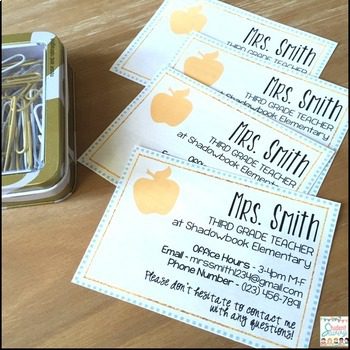
Source: StudentSavvy/Teachers Pay Teachers
- Elementary School: Most outside-school communication is between parents and teachers at this point, but kids should be encouraged to ask their own questions during the school day whenever possible. As they get older, parents should do their best to let kids take the lead.
- Middle School: Students should be almost entirely independent of parents when communicating with teachers now. They should know when teachers are available to chat in person (including before and after school, if possible). Adults can also show them how to write respectful emails or texts if teachers have made that contact information available.
- High School: At this point, students should be nearly 100% responsible for talking to their teachers when they need to. They should keep a contact list of email addresses, phone numbers, or other info. Additionally, they should recognize and respect preferred methods of contact.
Create Study Groups
While some kids work best on their own, many others thrive working with others to keep them on track and motivated. Setting up study buddies or groups enhances everyone’s study skills.

Source: MiddleWeb
- Elementary School: Parents will likely have to coordinate any in-person or online study sessions. Teachers can help by pairing students together as partners or for tutoring, and providing virtual study spaces when necessary.
- Middle School: As students get older, they should learn to seek out strong study partners. Help them recognize that their best friends may not always be the best choices when it comes to studying. Encourage them to have peers over to study, or to meet in public places like libraries.
- High School: Kids should be independently forming their own study support systems. However, they might ask teachers for help when they need one-on-one tutor recommendations. They may work together at school, at home, at the library, or online.
Use Resource Tools
There are more ways to learn and study than ever before. Help students find the right options to support their studies.
- Elementary School: Encourage students to look up answers in the right places: What does a word mean? Check the dictionary. When did the Civil War start? Here’s how to Google that. Help younger students use the resources to ensure they’re finding the information they need.
- Middle School: “Hey Google, how many moons does Jupiter have?” Kids this age know how to ask questions on the web. However, they need to learn how to make sure the answers are reliable. Teach them about primary sources (like following Wikipedia info back to its original source) and how to verify information in several different places.
- High School: A huge number of resources are online these days, so be sure students know where to find them and how to use them. Provide trusted online dictionaries and encyclopedias, show them how to seek out a thesaurus or rhyming dictionary, and guide them to video sites beyond YouTube, just to name a few.
How do you teach study skills in your classroom? Come share your ideas and ask for advice in the WeAreTeachers HELPLINE group on Facebook!
Plus, check out 15 Life Skills Every Teen Should Learn.
